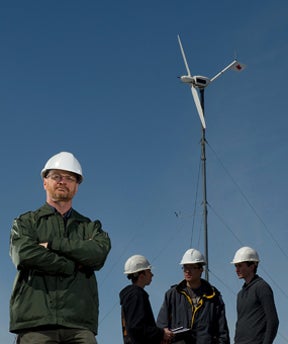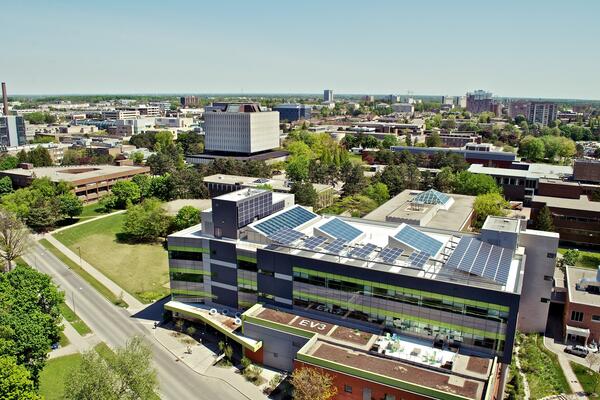
Bringing green energy to remote Canadian communities
Waterloo researcher hopes wind turbines will save money and the environment for First Nations that depend on diesel

Waterloo researcher hopes wind turbines will save money and the environment for First Nations that depend on diesel
By Christian Aagaard Marketing and Strategic CommunicationsOne day this summer, David Johnson hopes to catch up with friends in the shadow of a wind turbine turning in the breeze wafting in from Hudson’s Bay.
 It will be a poignant reunion for Johnson, an associate professor in the University of Waterloo’s Faculty of Engineering, and for the Wind Energy Group that is trying to coax the world off fossil fuel.
It will be a poignant reunion for Johnson, an associate professor in the University of Waterloo’s Faculty of Engineering, and for the Wind Energy Group that is trying to coax the world off fossil fuel.
The turbine, standing 30 metres tall in Kasabonika Lake First Nation, sits especially close to his soul. “This is definitely the get-you-out-of-bed-in-the-morning project, for sure,” Johnson says.
Wind energy has potential to cut energy costs
The turbine began producing power last July, saving a sip of diesel fuel with each 10-metre sweep of its blades.
To a listener in southern Ontario, that hardly sounds significant; but in remote Canadian communities, where diesel fuel to run electrical generators arrives in trucks driven across frozen lakes — or by plane —the potential for wind energy to cut costs is huge.
Options have tended to be awkward and clunky. Three older-technology wind turbines, installed by Ontario Hydro in 1997 as a test project, supplement the Kasabonika Lake power supply — when they work.
Waterloo wind turbine is easier to ship and simple to maintain
Using a product from Wenvor Technologies Inc. in Guelph, and experimenting with blades and cold-weather operation, Johnson says he has a model that meets two key objectives: ease of transport and ease of maintenance.
Another turbine, twin to the one in Kasabonika Lake, stands over the Wind Energy Group’s research facility at the Waterloo Regional landfill site on Erb Street. Researchers apply what they learn from it to the turbine spinning 1,460 kilometres northwest of Johnson’s office in Engineering 3.
"We want to design a new blade that takes full advantage of lower wind speeds,” Johnson says. “Our winds are very much like what they have up there.”
Hinged at the base, the Kasabonika turbine “bows” to the ground for repairs and modifications. It can be winched upright by somebody in a small vehicle.
Cost of installing turbines recovered in fuel savings
At 30 kilowatts (30,000 watts), the turbine’s output is dwarfed by the million-watt capacity of the diesel-powered generating station serving about 900 residents in Kasabonika Lake. The cost of installing several of them, however, would be quickly be recovered in fuel savings, Johnson says.
Embraced by the band council and supported by Hydro One Remote Communities Inc , Johnson’s pilot project went through a round of meetings, including a community forum with radioed call-ins and translation into and out of Oji-Cree. People wanted to know about noise and the possible impact on birds.
Johnson didn’t know much aboriginal culture when the project began in 2007. Seven years later, he holds a deep respect for his Kasabonika partners, who put the land ahead of themselves when they ask questions about the turbine.
“We wouldn’t put something up there that the community wouldn’t accept,” Johnson says.

Read more
Here are the people and events behind some of this year’s most compelling Waterloo stories

Read more
Energy is central to global sustainability and this Earth Day we highlight Waterloo's efforts on campus

Read more
Discover how Waterloo alumni are driving Canada’s economy with five tech companies making a local and global impact
The University of Waterloo acknowledges that much of our work takes place on the traditional territory of the Neutral, Anishinaabeg, and Haudenosaunee peoples. Our main campus is situated on the Haldimand Tract, the land granted to the Six Nations that includes six miles on each side of the Grand River. Our active work toward reconciliation takes place across our campuses through research, learning, teaching, and community building, and is co-ordinated within the Office of Indigenous Relations.